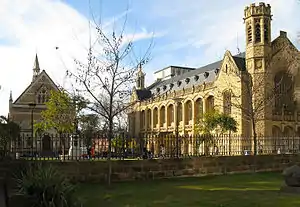Bonython Hall
Bonython Hall is the "great hall" of the University of Adelaide, located in the university grounds and facing North Terrace, Adelaide.[1] The building is on the now-defunct Register of the National Estate and the South Australian Heritage Register.[2][3] It is primarily used for University graduation ceremonies, examinations, expositions and public lectures and meetings likely to draw large audiences.[4][5]
| Bonython Hall | |
|---|---|
 Bonython Hall | |
 | |
| General information | |
| Type | Great hall |
| Architectural style | Gothic |
| Location | Adelaide, Australia |
| Address | North Terrace |
| Construction started | 1933 |
| Completed | 1936 |
| Cost | £50,000 |
| Owner | University of Adelaide |
| Design and construction | |
| Architect | Woods Bagot |
History
The hall was built in the period 1933-1936 as a result of a donation of over £50,000 from Sir John Langdon Bonython.[6] It was opened on 8 September 1936 by Governor-General Lord Gowrie and the first public lecture was held a week later.[7]
Folklore
There are many local legends about the building, with two being particularly resilient:
Bonython Hall is opposite Pulteney Street. Folklore has it that the Bonython donation was made on the condition that a hall be built opposite Pulteney Street, thus blocking any future path through the parklands and preventing the division of the campus by a major thoroughfare.[8]
Folklore also maintains that the Bonython family were very conservative and did not want the building used as a dance hall. Hence, the hall was designed and built with a sloping floor rather than flat floor.[4][5]
Renovation works
Beginning in 2005, the University has been conducting renovation works. The quality of these works has been rewarded with an Award of Merit at the 2007 UNESCO Asia-Pacific Heritage Awards for Culture Heritage Conservation.[1][8][9]
Gallery
 North Terrace, Adelaide, 1940. From left: National War Memorial, Institute, Mortlock Library, and Bonython Hall
North Terrace, Adelaide, 1940. From left: National War Memorial, Institute, Mortlock Library, and Bonython Hall Bonython Hall (right) and the Elder Conservatorium
Bonython Hall (right) and the Elder Conservatorium Bonython Hall (left) & the Ligertwood Building
Bonython Hall (left) & the Ligertwood Building Bonython Hall (looking west) and the Mitchell Building
Bonython Hall (looking west) and the Mitchell Building At night (looking east)
At night (looking east) The north end of Pulteney Street
The north end of Pulteney Street From the rear: Bonython Hall (left) and the Conservatorium
From the rear: Bonython Hall (left) and the Conservatorium From the rear: Bonython Hall (right) and the Napier Building
From the rear: Bonython Hall (right) and the Napier Building L to R: Mitchell Building, Conservatorium, Bonython Hall
L to R: Mitchell Building, Conservatorium, Bonython Hall
References
- "UN heritage award goes to Adelaide icon". University of Adelaide. Archived from the original on 6 July 2011. Retrieved 12 March 2009.
- "Bonython Hall, North Tce, Adelaide, SA, Australia - listing on the now-defunct Register of the National Estate (Place ID 6368)". Australian Heritage Database. Australian Government. 21 March 1978. Retrieved 23 August 2019.
- "Bonython Hall, The University of Adelaide (listing SA10878 )". Australia Heritage Places Inventory. Department of Sustainability, Environment, Water, Population and Communities. Retrieved 12 March 2009.
- Salkow, Howard (September 2005). "Helping a University treasure keep its cool". Adelaidean. University of Adelaide. Retrieved 12 March 2009.
- "University Heritage Walk: Keith takes a walk in the Adelaide City region of South Australia". Postcards SA. NWS Nine. Archived from the original on 12 March 2011. Retrieved 13 March 2009.
- "Bonython, Sir John Langdon (1848–1939)". Sir John Langdon Bonython. Australian Dictionary of Biography. Australian National University. Retrieved 12 March 2009.
- "Bonython Hall | Adelaidia".
- "Heritage hall is green and cool". University of Adelaide. 15 December 2005. Retrieved 12 March 2009.
- "Winners Announced for the 2007 UNESCO Asia-Pacific Heritage Awards for Culture Heritage Conservation". UNESCO. 11 September 2007. Retrieved 12 March 2009.